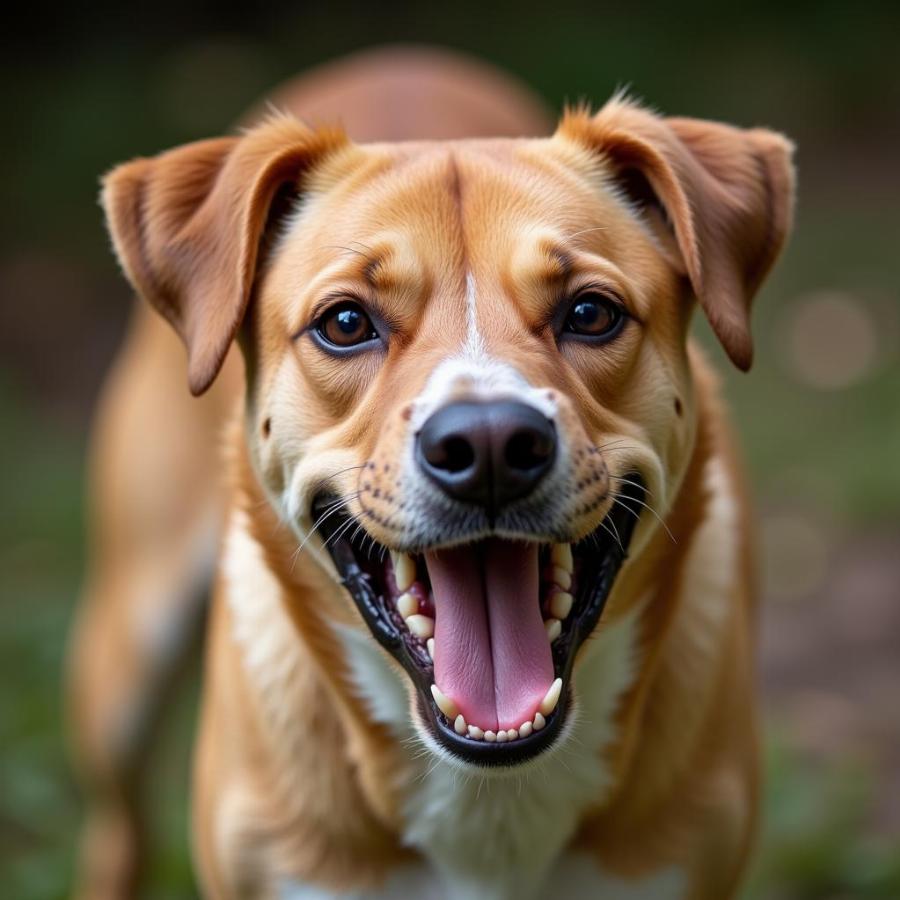The phrase “lady mauled by dogs” paints a chilling picture and highlights the devastating consequences of dog aggression. While dogs are often seen as loyal companions, understanding the factors that can contribute to aggressive behavior is crucial for preventing such tragic incidents. This article will delve into the complex issue of dog aggression, offering insights into its causes, signs, and most importantly, preventative measures.
Decoding Dog Aggression: Why Do Dogs Attack?
Dog aggression isn’t always a sign of a “bad” dog. It’s a complex behavior stemming from various factors, including genetics, upbringing, environment, and even underlying medical conditions.  A dog showing aggressive behavior, teeth bared, growling fiercely.
A dog showing aggressive behavior, teeth bared, growling fiercely.
Fear and Anxiety as Triggers
Often, aggression is a defense mechanism. A fearful or anxious dog might lash out if it feels threatened or cornered. This is particularly true for dogs with a history of abuse or neglect. They may perceive even friendly gestures as a threat.
Territorial Aggression: Protecting Their Domain
Dogs, like many animals, can exhibit territorial aggression, protecting their home, yard, or even their owner. This can manifest as barking, growling, or even biting at anyone they perceive as intruding on their space.
Protective Aggression: Defending Their Pack
Some dogs are fiercely protective of their family members, especially children. While this instinct is admirable, it can lead to aggression if the dog misinterprets a harmless interaction as a threat.
Possessive Aggression: Guarding Their Resources
Resource guarding, whether it’s food, toys, or even a favorite spot on the couch, can trigger aggressive behavior. A dog exhibiting this type of aggression might growl, snap, or bite if someone approaches their prized possessions.
Recognizing the Signs: How to Identify Aggressive Behavior in Dogs
Early identification of aggressive tendencies is key to prevention. While some signs are obvious, others are more subtle.
Body Language Clues
Pay attention to the dog’s body language. Stiff posture, raised hackles, a tucked tail, whale eye (showing the whites of their eyes), and lip curling are all potential indicators of aggression.
Vocalizations: Barking, Growling, and Snarling
Growling, snarling, and even excessive barking can be warning signs. Don’t dismiss these vocalizations; they are the dog’s way of communicating discomfort or potential aggression.
Preventing Dog Bites: Proactive Measures for a Safer Environment
Preventing dog bites requires a multi-faceted approach, focusing on responsible ownership, training, and creating a safe environment for both dogs and people.
The Importance of Early Socialization
Early socialization is crucial for puppies. Exposing them to a variety of people, places, and situations helps them develop into well-adjusted adults, less prone to fear-based aggression.
Consistent Training and Positive Reinforcement
Training plays a vital role in managing aggression. Positive reinforcement methods, focusing on rewarding desired behaviors, are generally more effective than punishment-based approaches.
Seeking Professional Help: When to Consult a Veterinarian or Behaviorist
If your dog exhibits signs of aggression, consult with a veterinarian or a certified dog behaviorist. They can help identify the underlying causes and develop a tailored behavior modification plan.
Conclusion: Creating a Harmonious Relationship with Dogs
While the phrase “lady mauled by dogs” serves as a stark reminder of the dangers of dog aggression, understanding the root causes and implementing preventative measures can significantly reduce the risk of such incidents. By prioritizing responsible ownership, early socialization, and consistent training, we can foster safer and more harmonious relationships between humans and our canine companions.
FAQs: Addressing Common Concerns about Dog Aggression
- Q: Are certain breeds inherently more aggressive? A: While some breeds have a predisposition towards certain behaviors, aggression is ultimately influenced by individual factors, not solely breed.
- Q: Can aggressive behavior be completely cured? A: While not always “cured,” aggression can be effectively managed with proper training and behavior modification techniques.
- Q: How can I protect myself if a dog attacks? A: Avoid direct eye contact, try to remain calm and still, and protect your face and neck. If knocked down, curl into a ball and cover your head.
Further Reading on Beaut Dogs
For more information on dog behavior and training, check out these related articles:
Beaut Dogs: Your Trusted Source for Canine Information
Beaut Dogs is your one-stop destination for all things canine, providing expert advice, insightful articles, and a wealth of information on dog breeds, care, training, and much more. When you need support or have questions, please email us at [email protected] for detailed and accurate answers. We’re committed to helping you build a strong and loving bond with your furry friend. Visit us at https://beautdogs.com today!